How Dictatorship and Internal Conflict Politicised Club Football Supporters in Italy and Spain
26/09/2023 - 9.04
Colin Phillips
With maybe the exception of Liverpool supporters, it is noticeable how little politics plays a part in the matchday experience in English football. Visits to other parts of Europe often have a very different feel. From overt right wing political displays at Lazio to the sight of Barcelona fans chanting “Libertad” and waving Catalonian flags. The expression of political beliefs seems far more intertwined with football for fans in Italy and Spain than it does in England.
Why might this be the case? Important factors in these differences could be that, unlike in England:
• Italy and Spain suffered political instability and totalitarianism at an important time in the game’s development;
• Mussolini and Franco used football as a political tool internally and externally to promote their regimes; and
• There are strong separatist sentiments in cities and regions within those countries.
In England, organised football took root in the late nineteenth century and early twentieth century during periods of relative internal political stability. Elected governments were either Tory or Liberal and, even when Labour began to gain popularity, many socialists disapproved of football as a distraction for the masses from the overarching objective of defeating capitalism. Clubs were paternalistic set-ups, with either church teams that evolved into clubs like Wolverhampton Wanderers (St. Lukes) and Everton (St. Domingos), for example, or factory teams like Darwen (Textile Industry), West Ham (Thames Ironworks) or Arsenal (Dial Square Munitions Factory). The ruling classes saw little international prestige in promoting football - so much so that England didn’t even bother to enter the World Cup until after the Second World War.
England exported the game to foreign shores, of course, and the transformation of football into a mass participation sport occurred later in Italy and Spain. This transformation happened during a background of very different internal political situations with Mussolini creating a Fascist state in Italy in the 1920s and Franco triumphing in a bloody civil war in Spain in the 1930s. These dictators sought to utilise the growing popularity of football as a political tool. They saw, according to Benoit, the international prestige and portrayal of regime identity that football enabled. A source of propaganda that could create national pride and legitimise their movements. Indeed, Mussolini revelled in the World Cup triumphs of 1934 and 1938, despite allegations that officials had been hand-picked for key matches in the 1934 Italian hosted World Cup. His press officer, Lando Ferretti, suggested these wins “…symbolised the rise of the Fascist Italian nation.” Despite not originally being a football fan, Franco saw how football had helped revitalise Italy and tried to do the same with the Spanish national team, helping them win the European Championships in 1964.
These successes didn’t occur overnight of course. The dictators had to unite their previously fragmented countries by setting up infrastructures that would promote success. Italy had been merely a set of disparate states until the Risorgimento in 1861. Mussolini quickly defined football as Italy’s national sport. The ‘Carta di Viareggio’ set out the rules and the principles of the game in 1926 and a nationwide league, Serie A, was founded in 1929. Traces of the English founders of the game were removed with clubs being renamed – for example the ‘Genoa Cricket and Football Club’ became ‘Genova 1893 Circolo del Calcio’ in 1928. The term ‘football’ was replaced by the Italian word ‘calcio’. Rome was strengthened by unifying the many existing clubs, making Mussolini closely associated with Lazio. Other new clubs were formed and became associated with the regime, including AS Roma and Fiorentina, the latter who were owned by Ridolfi, a key Mussolini ally.
Magnificent new stadiums in Rome, Bologna and Florence embodied the new Fascist regime with pride and enabled the strength of a new Italy to be paraded internationally as they hosted (and won) the FIFA World Cup in 1934. As Foot states “Fascism was good for Italian Football, and football was good for Fascism”.
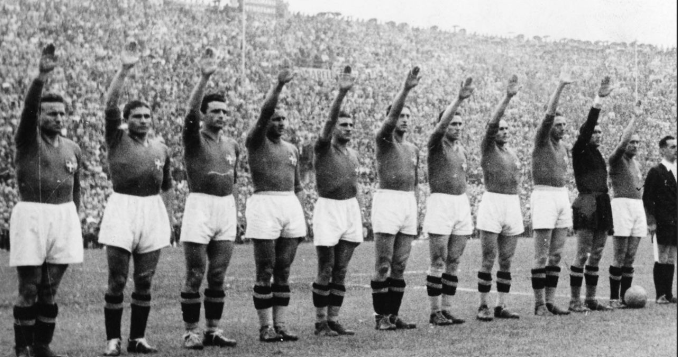
The Italy Team Salutes “Il Duce” at the 1934 World Cup. Source: FIFA World Cup News: https://www.fifaworldcupnews.com/1934-fifa-world-cup-rome-italy/
MacWilliam considers that the “Hispanicisation” of Spain after the Civil War stretched into the organisation of football. Franco was well aware of the power of the game to influence the behaviour and attitudes of the population, so he instituted a Ministry of Sport, led by loyal nationalists, to disseminate state propaganda and use football to distract people from poverty. Mirroring Italy, football was under the full control of the regime with clubs renamed in ‘Christian’ Castilian to represent a ‘new’ unitary Spain – Madrid FC became ‘Real Madrid Club de Futbol’, for example. Each club had to have two members loyal to the regime on their board – which meant that, according to Spanish historian Quiroga that “…it was very difficult for players with Republican sympathies to reintegrate to football after the war”.
Franco seemingly had a very close relationship and association with Real Madrid after the war. Aided by pressure from regime officials, the transfer of Alfredo di Stefano was allegedly snatched from under the nose of Barcelona in 1953. The fact that Real President Santiago Bernabeu was a key Franco loyalist and former Nationalist soldier added fuel to the fire that Barcelona claimed was regime favouritism.
Franco tried to use the Spanish national team, in the same way Mussolini used the Italian one. In 1964, Spain hosted the European Championship and were victorious, giving the message, according to Carmichael that “This was Spain: strong, independent and united. This was Franco’s vision, played out as a reality in front of a global audience”. Real were even more of a success, winning 5 European Cups in the 1950’s and 1960s and boosting the prestige of the Franco regime.
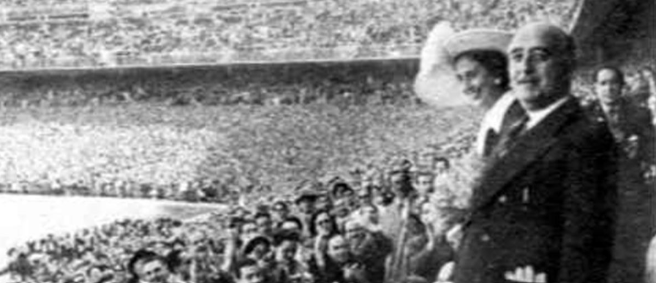
Franco Pictured Before a Real Madrid Match. Source: El Periódico: https://www.elperiodico.com/es/politica/20180416/documentos-franco-psuc-real-madrid-archivo-fundacion-6756601
It is considered that English hooligan groups developed in the late 1960s and 1970s but, beyond a few clubs’ fans trying to whip up racist and nationalist propaganda on behalf of the National Front at places like Chelsea and Millwall, it never amounted to sustained political activity on the terraces. Armstrong states “The political system of Britain never accommodated extremist opinion, unlike that of Spain and Italy.”
Of course, people are not universally compliant to propaganda and, in Italy, a bitter civil war united anti-fascists against Mussolini’s regime at the end of the Second World War. The prolonged struggles meant that people carried their allegiances and extreme opinions long after the demise of Mussolini. Italy failed to definitively break with fascism or even begin to come to terms with its past. Fascism, and the acceptance of extreme political opinions, was, unlike in England, still seen as acceptable to many.
The late 1960s brought on a period of political instability and turmoil in Italy known as the ‘years of lead’ where this unresolved civil war was played out. Lee states that “…political tensions on the street were transferring to the stadium” and “…organised groups of fans with a hierarchy, a belief system and an identity congregated in the curve (stands) behind the goals at stadiums across Italy.”
Ultras took on military names such as Brigate, Corps and Boys and were deeply political. Armstrong studied in depth the formation, growth and political activities of the Lazio ultras ‘Irriducibili’ who were promoting fascism and often clashing with the left wing (at the time) ultras from AS Roma. Across the country ultras would assert their identity with choreographed displays and political messaging at stadiums.
Underlining differences with English fans, whose hooligan culture many Italians emulated, Foot states “Unlike hooligans, the ultras have adopted forms of self-organisation similar to those found in political groups and amongst social movements”. The fashion and violence of English fans were emulated but taken to the next level with a political component.
Armstrong goes on “At stadia across Italy curve embrace a political ideology, be it rossa (red, communism) or nera (black, neo-fascism)” representing the social and political history of their area. So, Livorno, a working class sea-port will be rossa and Lazio nera. Cities with two clubs, according to Martin and unlike in England “…often had distinctive political identities, as in AC Milan being the traditional team of the railway workers/working class and their rivals Internazionale representing the more conservative bourgeoisie”. Clubs in the Northern League (Lega Nord) region of Lombardy or Veneto were often anti- southern and hostile to immigrants. Many groups were and are intensely community focussed. Jones states “…the foundation of every ultra group is “campanilisimo” (the attachment to one’s local belltower”). He notes how, for example, Cosenza ultras gave beds to immigrants and the destitute, set up foodbanks and play parks for disabled children.
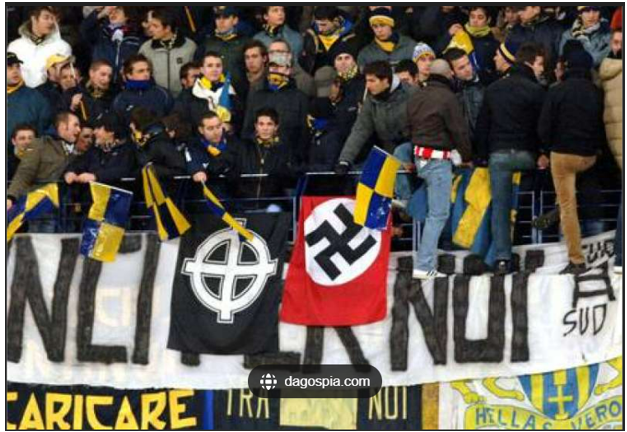
Hellas Verona Fans Displaying a Swastika and a Fascist Symbol. Source: La Repubblica: https://www.repubblica.it/cronaca/2019/06/07/news/_siamo_una_squadra_a_forma_di_svastica_il_coro_nazi_degli_ultra_del_verona_finisce_in_procura-228138889/
The ultras still thrive today. The election of far-right Berlusconi appeared, if anything, to legitimise the use of fascist slogans. Many players also felt free to express their political beliefs with Cannavaro, Buffon and Di Canio all being openly sympathetic to fascism in recent decades.
In Spain, the Real Madrid association, the scars of the Civil War and subsequent Hispanicisation efforts of Franco served to embed politics into the collective psyche of football. Sid Lowe cites the banning of the Catalan and Basque languages and burning of history books as Franco sought to purge non-Spanish traditions. Carmicheal confirms that “…football was used as a natural vehicle with which citizens protested his oppressive regime. Stadiums became a hotbed of political debate”. The resulting separatist movements meant that the football stadiums at Barcelona (Catalan) and Atletico Bilbao (Basque) - to name the two most prominent examples, - were places where fans could gather, speak in their “native tongue” and protest. Carmichael, talking of Barcelona, goes on - “…a movement had been born, one encapsulated by the club’s new motto: Mes que un Club, more than a club”. Martin backs this up wholeheartedly, stating “As in Italy, the Francoist promotion of football to construct national unity was flawed, as it was through this specific medium that Basque and Catalan nationalism found the best opportunity for public expression”. Such separatist sentiment is not a serious consideration in England of course.
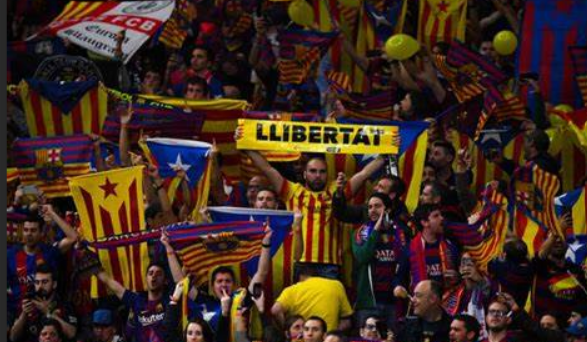
Barcelona Fans with Catalonian Flags Demanding “Liberty”. Source: HITC: https://www.hitc.com/en-gb/2018/04/30/barcelona-fans-demand-deal-for-christian-eriksen-to-replace-andr/
Similar to Italy, ultra groups emerged on Spanish terraces in the 1970s and 1980s. Sandoval states that Spanish ultras “…were influenced by the hooligans of England and the Italian radical groups”. He goes on “…in Spain the characteristic feature of the ultra-groups has the ideological component that articulates most radical groups in our country. A link between politics and football violence. An explosive cocktail.”
Many football clubs had also already developed from a political setting. Sevilla was seen as a middle-class club, but Real Betis grew from the working-class areas of the same city who were excluded – and a fierce rivalry developed. Espanol was seen to represent Spain itself against the ‘foreigners’ of Barcelona.
Ultras across Spain grew with clubs like Raya Vallecano, a historically anti-Franco club with fans labelled Bukaneros with socialist leanings being the third club in Madrid and Sevilla with the leftist Biris Norte. Right wing (or Francoist) ultra groups can be found at Real Madrid (Ultras Sur), Atletico Madrid (Front Atletic), Espanol (Blanquiazules Brigades) and Valencia (Ultras Yomos). Separatist groups from regions who want to be independent from Spain can be found at Barcelona (Boys Boixos) and Athletic Bilbao (Herri Norte) as above, but also at Celta Vigo (Celterras), Osasuna (Red Force) and Deportivo La Coruna (Riazor Blues).
It is interesting that whereas the regions in Italy are loosely affiliated, most fan political activity is seen through the prism or right wing/ left wing or fascist/ anti-fascist. It seems that the bitter Civil War in Spain helped to foment deeper separatist movements that add a distinctive feature to political activity in the football stadium.
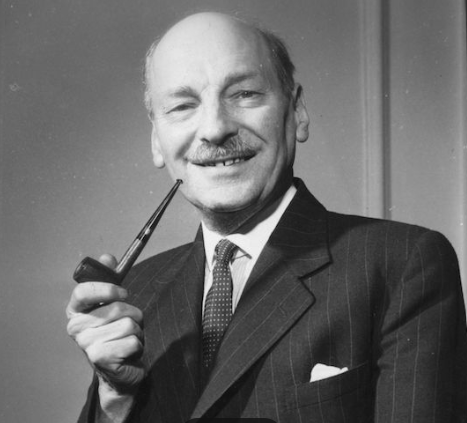
Clement Attlee. Unlikely to be seen adorning Flags at an English Ground any time soon. Source: Jewish Telegraphic Agency: https://www.jta.org/2018/11/21/global/clement-attlee-postwar-prime-minister-britain-took-jewish-child-fleeing-nazis
In conclusion, it is clear that the impact of dictatorship and subsequent validation of what the English would consider extreme views are key to understanding what makes English club fans less political than those in Spain and Italy. The separatist and regional movements in those countries, that are not really present in England, often helps to create a potent mix. As Lee writes “A century on from Mussolini’s takeover of power, Italian football is still political, featuring activity from both extremes”. In Spain, the effects of Franco still reverberate around football stadia in La Liga. Tobias Jones notes that many far-right football supporter groups still have busts of Mussolini in their headquarters. It is unlikely that club supporters in England anywhere are paying similar homage to Clement Attlee or Winston Churchill…
References
Armstrong, Gary and Testa, Alberta (2010) – Football, Fascism and Fandom. The Ultras of Italian Football
Benoit, Macon (2008). "The politicisation of football: the European game and the approach to the Second World War". Soccer & Society.
Carmichael Charlie (2016), “Franco, Fascism & Football: How an oppressive political regime changed the face of modern Spain.” Franco, Fascism & Football: How an oppressive political regime changed the face of modern Spain — NPLH - No Place Like Home (nplhmag.com)
Fitzpatrick, D and Hoey P (2022) From fanzines to foodbanks: Football fan activism in the age of anti-politics (https://researchonline.ljmu.ac.uk/id/eprint/16478/11/From%20fanzines%20to%20foodbanks.pdf)
Foot, John (2006), Calcio, A History of Italian Football
Jones, Tobias (2020) Ultra, The Underworld of Italian Football
Lee, Chris (2022), The Defiant, A History of Football against Fascism
Lowe, Sid (2013). Fear and Loathing in La Liga: Barcelona, Real Madrid, and the World's Greatest Sports Rivalry
MacWilliam, Rab (2019) Life in La Liga, The Story of Spanish Club Football
Martin, Simon (2018) Football, fascism and fandom in modern Italy (https://www.eurozine.com/football-fascism-fandom-modern-italy/)
Parks, Tim (2002) A Season With Verona. Travels around Italy in search of Illusion, National Character and Goals
Sandoval, Koldo (2019) The most radical ultras groups in Spain (colgadosporelfutbol.com)
Biography
Colin Phillips is 52 and lives in Tring, Hertfordshire. He recently went back to university to complete a Masters in International Relations and U.S. Politics at Keele University. His chosen dissertation topic was "European Club Football - Supporters and Politics" for which he completed a comprehensive survey of football supporters and political attitudes and activities at clubs across Europe. He works as a project manager but is involved in football as part of the Management Team at Tring Athletic Under 23s. He can be contacted at colinbphillips@hotmail.com



/prod01/wlvacuk/media/departments/digital-content-and-communications/images-18-19/iStock-163641275.jpg)
/prod01/wlvacuk/media/departments/digital-content-and-communications/images-2024/250630-SciFest-1-group-photo-resized-800x450.png)
/prod01/wlvacuk/media/departments/digital-content-and-communications/images-18-19/210818-Iza-and-Mattia-Resized.jpg)
/prod01/wlvacuk/media/departments/digital-content-and-communications/images/Maria-Serria-(teaser-image).jpg)
/prod01/wlvacuk/media/departments/digital-content-and-communications/images-2024/241014-Cyber4ME-Project-Resized.jpg)
/prod01/wlvacuk/media/departments/digital-content-and-communications/images-18-19/210705-bric_LAND_ATTIC_v2_resized.jpg)